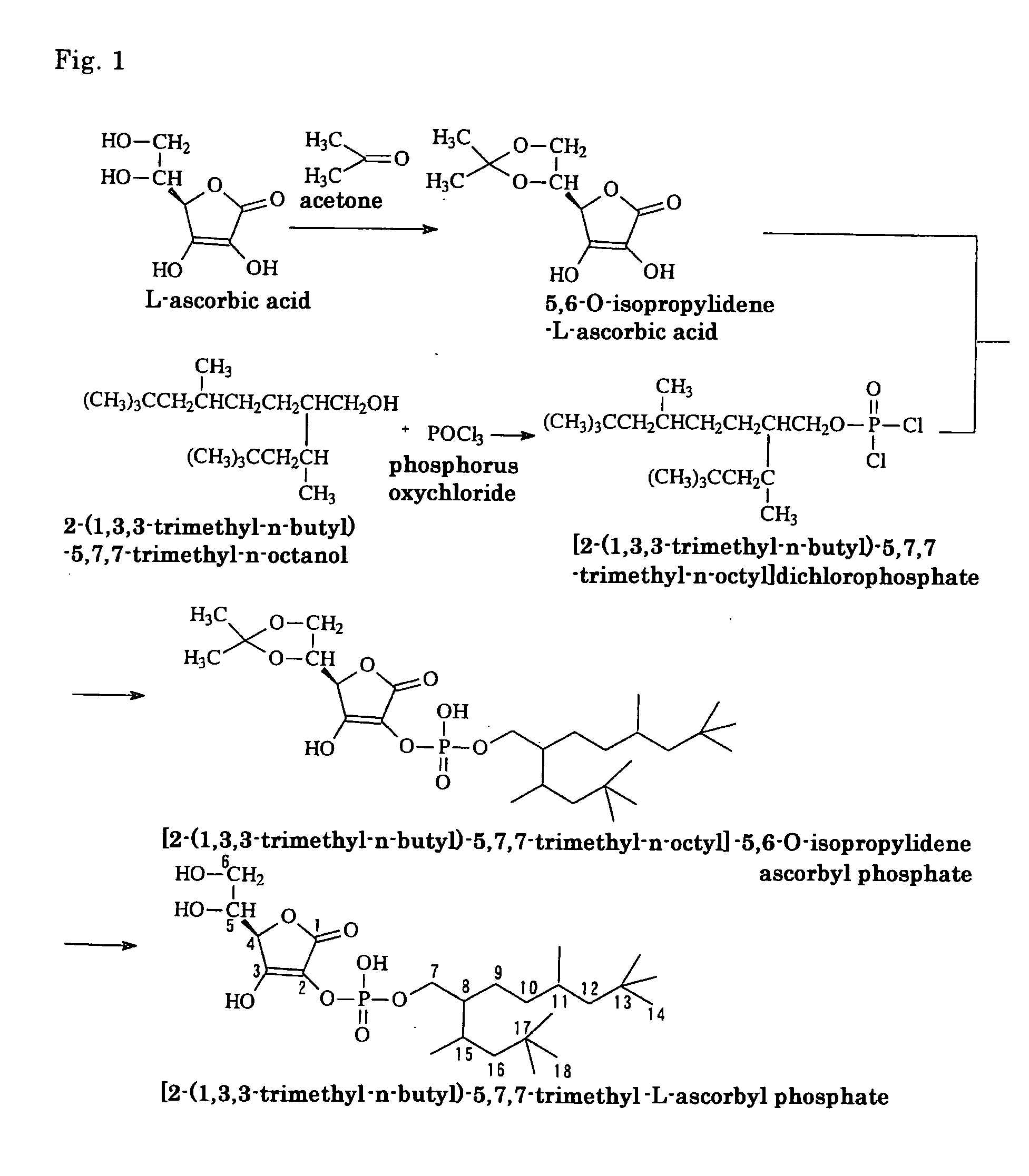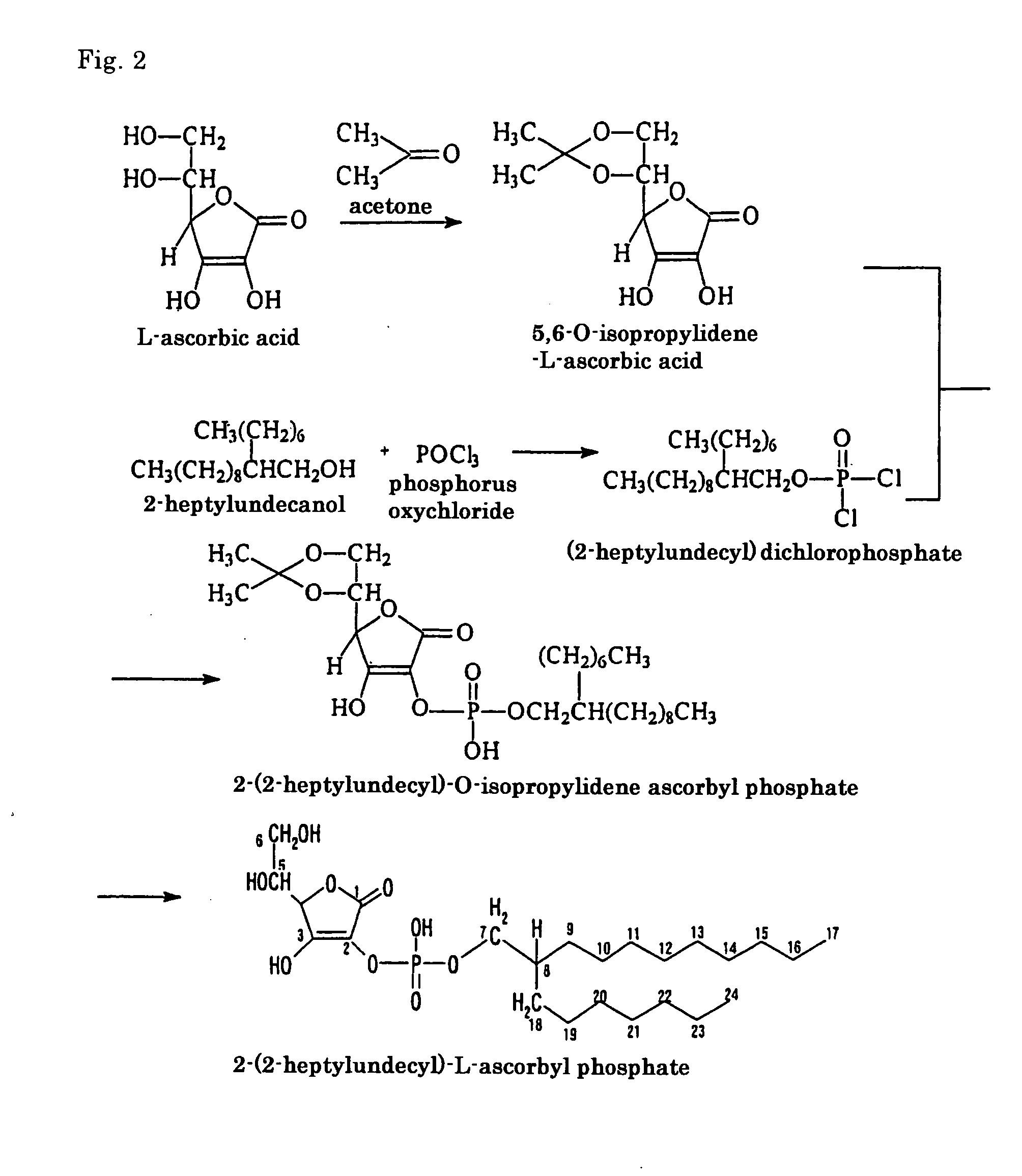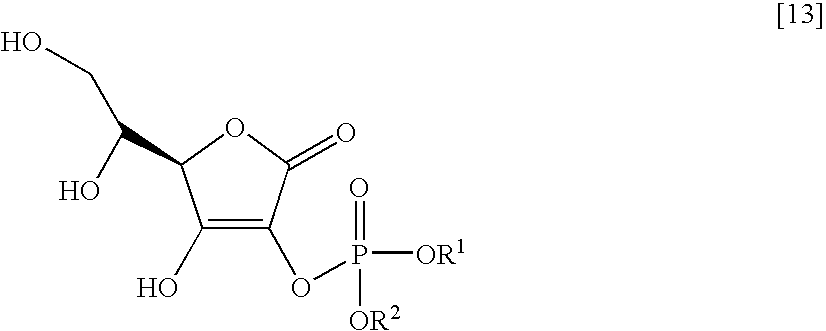Ascorbic acid derivatives and skin-whitening cosmetics
a technology of ascorbic acid and derivatives, applied in the field of ascorbic acid derivatives, can solve the problems of difficult for l-ascorbic acid to fully exhibit the expected physiological function, become inert or decompose, so as to inhibit the decomposition of l-ascorbic acid, and improve the effect of skin whitening
- Summary
- Abstract
- Description
- Claims
- Application Information
AI Technical Summary
Benefits of technology
Problems solved by technology
Method used
Image
Examples
example 1
Production Example 1 of Ascorbic Acid Derivative
[0046] As will be apparent from the production steps shown by reaction formulas in FIG. 1, 2-(1,3,3-trimethyl-n-butyl)-5,7,7-trimethyl-n-octanol, which is a branched alkanol, was reacted with phosphorus oxychloride to synthesize [2-(1,3,3-trimethyl-n-butyl)-5,7,7-trimethyl-n-octyl]dichloro-phosphate, which is a monoalkyl dichlorophosphate. The thus synthesized substance was reacted with 5,6-O-isopropylidene-L-ascorbic acid obtained by reacting L-ascorbic acid with acetone, and the thus produced isostearyl-2-O-isopropylidene ascorbyl phosphate was hydrolyzed with hydrochloric acid, washed, isolated and purified to produce 2-(2-(1,3,3-trimethyl-n-butyl)-5,7,7-trimethyl-n-octyl)-L-ascorbyl phosphate. (In FIG. 1, the assigned numbers of peaks at 13C-NMR, which is described later, are indicated.) Now the individual synthesis steps are described in detail.
(1) Synthesis of 5,6-O-isopropylidene-L-ascorbic acid
[0047] With nitrogen substituti...
example 2
Production Example 2 of Ascorbic Acid Derivative
[0053] Except that 2-(1,3,3-trimethyl-n-butyl)-5,7,7-trimethyl-n-octanol as used in Example 1 was used in the molar ratio of 2.0 based on phosphorus oxychloride, a compound was produced in exactly the same manner as in Example 1. The compound obtained was identified by infrared absorption spectrum (IR) and nuclear magnetic resonance spectrum (1H-NMR, 13C-NMR). The results (groups or carbon atoms corresponding to the peak positions) are shown in Tables 4 to 6.
[0054] It was confirmed that the thus obtained compound was an ascorbic acid derivative having the desired molecular structure, i.e. 2-bis[2-(1,3,3-trimethyl-n-butyl)-5,7,7-trimethyl-n-octyl]-L-ascorbyl phosphate (91.1% in purity). The yield was 20.1% (based on L-ascorbic acid).
[0055] The molecular structure of the thus obtained compound is shown by formula [9], which includes the assigned numbers of peaks at 13C-NMR.
TABLE 4[9]KBrIR(cm−1)3394(OH)1731(C═C)2955(CH2)1469(CH3)2905...
example 3
Production Example 3 of Ascorbic Acid Derivative
[0058] Except that instead of 2-heptylundecanol as used in Example 1, 2-hexyldecanol was used, a compound was produced in exactly the same manner as in Example 1. The compound obtained was identified by infrared absorption spectrum (IR) and nuclear magnetic resonance spectrum (1H-NMR, 13C-NMR). The results (groups or carbon atoms corresponding to the peak positions) are shown in Tables 7 to 9.
[0059] It was confirmed that the thus obtained compound was an ascorbic acid derivative having the desired molecular structure, i.e. 2-(2-hexyldecyl)-L-ascorbyl phosphate (69.7% in purity). The yield was 63% (based on L-ascorbic acid).
[0060] The molecular structure of the thus obtained compound is shown by formula [10], which includes the assigned numbers of peaks at 13C-NMR.
TABLE 7[10]KBrIR(cm−1)3352(OH)1677(C═C)2956(CH2)1467(CH3)2926(CH)1219(P═O)2856(CH2)1040(P—O—C)1764(C═O)
[0061]
TABLE 81H-NMRδ (ppm) from TMS in CD3OD0.89(CH3-15, 23, t, 6H)...
PUM
| Property | Measurement | Unit |
|---|---|---|
| molar ratio | aaaaa | aaaaa |
| weight | aaaaa | aaaaa |
| pH | aaaaa | aaaaa |
Abstract
Description
Claims
Application Information
 Login to View More
Login to View More - R&D
- Intellectual Property
- Life Sciences
- Materials
- Tech Scout
- Unparalleled Data Quality
- Higher Quality Content
- 60% Fewer Hallucinations
Browse by: Latest US Patents, China's latest patents, Technical Efficacy Thesaurus, Application Domain, Technology Topic, Popular Technical Reports.
© 2025 PatSnap. All rights reserved.Legal|Privacy policy|Modern Slavery Act Transparency Statement|Sitemap|About US| Contact US: help@patsnap.com



